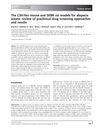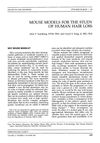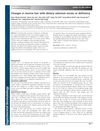TLDR Too much or too little selenium in the diet can cause hair loss and graying in mice.
In a study from 2011 involving 15 C57BL/6 mice, the effects of dietary selenium (Se) on hair growth were examined over a 24-week period. The mice were divided into three groups, each receiving diets with either excessive, adequate, or deficient levels of Se. The results showed that both excessive and deficient Se intake led to the development of alopecia with poliosis, unlike the group with adequate Se intake. Histological analysis revealed an increase in telogen hair follicles and epidermal atrophy in the groups with imbalanced Se levels. Furthermore, there was a notable decrease in the anti-apoptotic protein Bcl-2 and an increase in the pro-apoptotic protein Bax in the excessive-Se group when compared to the adequate-Se group. The study concluded that an imbalance in Se affects the hair follicle cycle and promotes hair loss with poliosis, which is partly due to changes in the Bcl-2/Bax ratio that induce apoptosis in keratinocytes.
10 citations
,
June 2009 in “Acta Biochimica Polonica” Old C57BL/6 mice with unsynchronized hair cycles show less melanin in their spleens.
 59 citations
,
September 2008 in “Experimental dermatology”
59 citations
,
September 2008 in “Experimental dermatology” Both mouse and rat models are effective for testing alopecia areata treatments.
16 citations
,
December 2005 in “Journal of Animal Physiology and Animal Nutrition” Moderate selenium levels in a dog's diet are best for hair growth.
 106 citations
,
June 2005 in “Journal of Investigative Dermatology”
106 citations
,
June 2005 in “Journal of Investigative Dermatology” The document concludes that assessing hair follicle damage due to cyclophosphamide in mice involves analyzing structural changes and suggests a scoring system for standardized evaluation.
35 citations
,
January 2001 in “Journal of Animal Science” High dietary selenium, especially inorganic, causes weight loss and selenosis in pigs, with effects varying by hair color.
 36 citations
,
October 1996 in “Dermatologic Clinics”
36 citations
,
October 1996 in “Dermatologic Clinics” Mice are useful for researching human hair loss and testing treatments, despite some differences between species.
 October 2018 in “Vestnik dermatologii i venerologii”
October 2018 in “Vestnik dermatologii i venerologii” Certain growth factors affect hair loss in women and could be targeted for treatment.

Baldness is often hereditary and linked to male hormones, becoming noticeable when half the hair is lost.

Some treatments like minoxidil, finasteride, and surgery can help with hereditary hair loss.
10 citations
,
June 2015 in “Seminars in cutaneous medicine and surgery” Hair loss can be caused by various factors, and treatments focus on restoring normal hair growth.
August 2014 in “Journal of drug discovery and therapeutics” Topical minoxidil and oral finasteride can help regrow hair in androgenetic alopecia.
 6 citations
,
March 2011 in “Experimental Dermatology”
6 citations
,
March 2011 in “Experimental Dermatology” Too much or too little selenium in the diet can cause hair loss and graying in mice.
189 citations
,
May 1991 in “Medical Entomology and Zoology”







